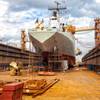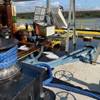In recent years, one of the more controversial things OSHA has done in the Shipbuilding industry is prohibit the use of safety belts in Personal Fall Arrest Systems. Although it is fair to say most of the industry saw the wisdom in this, there were a large number of companies that felt the switch to fullbody harnesses was a needless expenditure that would not result in any significant improvement in safety.
One shipyard reported to OSHA it was not in favor of immediately switching to safety harnesses because they owned approximately 4,000 safety belts and replacing them immediately would cost $570,000. While a half a million dollar investment might make a company think twice, I believe it is a very reasonable price to pay for the vast improvement in the fall protection afforded by fullbody harnesses.
When used in a Personal Fall Arrest System, the safety belt presents several problems, some of which are not well known.
The most widely recognized problem with safety belts is injury associated with "jack-knifing;" when a person falls and the body folds in half in response to the arresting force. If the safety belt is worn properly, with the D-ring in the back, this results in the "nose-to-toes" posture. A large amount of force is suddenly directed at relatively soft tissues during jack-knifing which can result in a lacerated liver, ruptured spleen, broken ribs, or back injury.
If injury does not occur from the initial application of force during jack-knifing, the force associated with prolonged suspension from a safety belt can have serious consequences. While suspended in a safety belt, the entire weight of the body is supported by a few square inches of material immediately below the ribcage. Compression in this area impacts three critical anatomical structures: the aorta; the vena cava; and the diaphragm. The aorta and the vena cava are the two largest blood vessels in the body. If the flow through these vessels becomes restricted, changes will occur in the blood pressure and the heart rate, which can result in the individual losing consciousness, or possibly, developing ventricular fibrillation. Experiments with dogs have demonstrated suspension in a safety belt can induce ventricular fibrillation, which usually ends in cardiac arrest. The diaphragm is the muscle primarily responsible for respiration. Suspension in a body belt forces the organs in the abdomen against the diaphragm and restricts its range of motion. This causes labored breathing and, over time, can lead to asphyxiation. The Air Force conducted a study of individuals suspended in safety belts and found the combination of impaired circulation and respiration was unbearable to most test subjects in less than two minutes.
A possibility usually worse than jack-knifing is falling out of the body belt. Most people wear the safety belt around their waist, which can result in a head-down position after the arrest, which can cause the belt to slip off. If you read the instructions on the use of a body belt, you will discover the device is supposed to be positioned just below the ribcage - not on the waist. Since most people's center of gravity is located above the navel, this positioning tends to rotate the body into a head-high posture after the arrest. If the safety belt slips with the body in a head-high posture, the safety belt is caught under the armpits, thereby preventing a fall to the ground.
Fullbody safety harnesses do not suffer from any of these problems. They are designed to distribute the forces of a fall arrest across the body in a controlled manner so as to minimize the potential for injury. One way this is accomplished is by orienting the body vertically during the fall arrest. The human body is best suited to dealing with large forces in the vertical plane since we spend most of our day in an upright posture.
The other way this is accomplished is by designing the seat of the fullbody safety harness to transfer most of the arrest force to the body. The seat of the harness contacts large bones, such as the pelvis and femurs, and the large muscles in the legs and buttocks. These structures require forces larger than those typically associated with a fall arrest to produce significant injury. Even if significant injury does occur, the injury is not likely to be life threatening.
Although OSHA no longer considers safety belts acceptable for fall arrest applications, they are still allowed in positioning systems. The reason for this is that in positioning systems the safety belt serves as a restraining device that prevents the wearer from falling. Since the wearer is never actually subjected to the force of a fall arrest while wearing the safety belt in this application, none of the problems associated with the use safety belts in fall arrest systems occur.
Charles Simpson, CSP, is a New Orleans-based consultant, specializing in safety issues related to hazardous chemicals. He can provide assistance with training and the development of written safety programs. Contact him at Safety Consulting Associates; tel: 504-624-8060.
Sponsored Content
Safer Starts Here: Build Ships, Protect Crews

Featured videos

Corn Belt Ports Streamlines Critical Agriculture River Shipments

“One Man, One Wrench” Launched a Global Maritime Power Play

Cat Pushes Forward on Hybrid Electric Solutions, Alternative Fuels
Subscribe for
Maritime Reporter E-News
Maritime Reporter E-News is the maritime industry's largest circulation and most authoritative ENews Service, delivered to your Email five times per week









